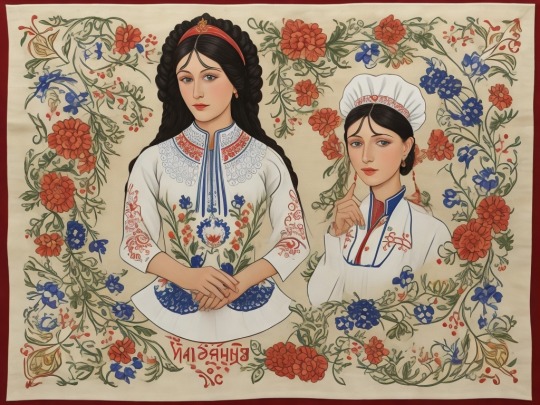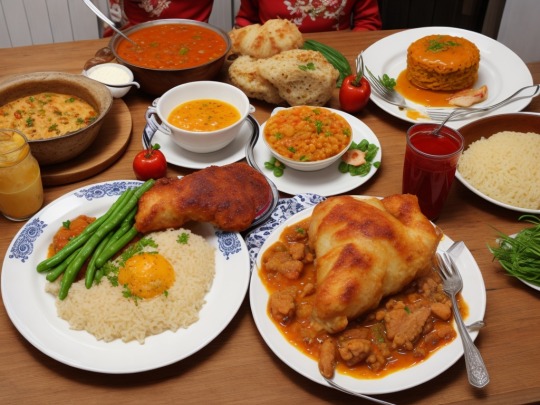Text

Ukrainian vyshyvanka
Ukrainian vyshyvanka is a symbol of Ukrainian culture and national identity. It has a rich history and deep traditions. Here’s a brief overview of the history and significance of Ukrainian vyshyvanka:
History:
Vyshyvanka has existed in Ukraine for many centuries. The first mention of vyshyvanka on fabrics in Ukraine dates back to the 17th and 18th centuries.
Initially, vyshyvanka was done exclusively by hand, using needles and threads.
Each region of Ukraine has its own unique vyshyvanka with its own ornaments, colours and symbols.
Throughout history, vyshyvanka has been used as a symbol of national identity and the struggle for independence.
Traditions:
Ukrainian vyshyvanka has deep symbolic meanings. The designs of vyshyvanka often reflect nature, flora, the sun and other symbols of spiritual significance.
The colours of vyshyvankas also have their own meaning. For example, red can symbolise strength and love, black – mourning, white – purity and innocence, yellow – the sun and gold.
Vyshyvankas were worn for festive and religious events, weddings, folk and national holidays.
Vyshyvanka also had a practical meaning – it protected from the cold, provided comfort and health.
Modern times:
Ukrainian vyshyvanka has always been popular among Ukrainians, but in recent years it has gained worldwide fame and recognition.
Today, vyshyvanka can be seen both on the streets and on fashion catwalks. They have become a symbol of national pride and cultural diversity.
Ukrainian designers and vyshyvanka craftsmen combine traditional elements with modern styles, adding a new artistic dimension to the vyshyvanka.
Ukrainian vyshyvanka is not just a garment, but a symbol of national identity, cultural heritage and pride. It is a testament to the richness of Ukrainian culture and heritage that has been passed down from generation to generation.
Read more: https://heritageukraine.pp.ua/
2 notes
·
View notes
Text

Digitalisation in Ukraine
Digitalisation in Ukraine is the process of introducing and developing digital technologies in various areas of society. Here are some key aspects of digitalisation in Ukraine:
E-governance: The Government of Ukraine is actively working on the electronisation of administrative services and government processes. This includes the introduction of electronic services, electronic documents, e-voting, and other tools to facilitate citizen interaction with government agencies.
E-commerce: Online commerce is growing in popularity in Ukraine. Online shopping, electronic payments and delivery of goods have become widespread. This allows entrepreneurs to expand their market and simplify the process of selling goods and services.
Digital education: Ukraine is actively developing digital education by introducing information technology into educational processes. Schools and universities have access to digital resources, online courses…
Read more: https://heritageukraine.pp.ua/
1 note
·
View note
Text

Traditional Ukrainian dishes
Ukraine is famous for its rich culinary heritage, which includes a variety of traditional dishes. Here are some of the most famous of them:
Borsch: This is one of the most popular Ukrainian dishes. Borsch is a soup made from red beetroot, potatoes, cabbage, carrots and other vegetables, with a special flavour due to the addition of meat or mushrooms. Variations of borscht may include different ingredients, such as beetroot, beans or lard.
Varenyky: This is a classic Ukrainian dish that consists of dough that is filled with a variety of fillings. Popular variations of varenyky include potatoes, cheese, stewed cabbage, cherries or plums. They can be served with cream, sour cream or butter.
Stuffed cabbage: This is a dish made from minced meat that is wrapped in cabbage leaves. Stuffed cabbage is baked or stewed in a sauce and served with potatoes or sauerkraut…
Read more: https://heritageukraine.pp.ua/
1 note
·
View note
Text
The school system in Ukraine
The school system in Ukraine is structured in a similar way to many other countries. Here are some key points about the school system in Ukraine:
Compulsory Education: Education in Ukraine is compulsory for children aged 6 to 17 years. This includes primary, secondary, and high school education.
Levels of Education: The school system is divided into several levels: primary education (grades 1-4), basic secondary education (grades 5-9), and senior secondary education (grades 10-12).
Curriculum: The national curriculum in Ukraine covers a wide range of subjects, including Ukrainian language and literature, mathematics, foreign languages (usually English), natural sciences, social sciences, physical education, arts, and technology.
Grading System: The grading system in Ukrainian schools typically uses a scale of 1 to 12, with 12 being the highest score. The passing grade is usually considered to be 4 or higher.
Standardized Testing: At the end of basic secondary education (grade 9), students take external examinations known as the External Independent Evaluation (ZNO). These exams assess students’ knowledge and are used for university admissions.
School Year: The school year in Ukraine usually starts in September and ends in May or June, with breaks for vacations.
School Types: There are different types of schools in Ukraine, including public schools, private schools, specialized schools (with focus on specific subjects or areas), and international schools.
Higher Education: After completing secondary education, students can pursue higher education at universities, colleges, or vocational schools. Ukraine has a number of universities that offer a wide range of academic programs.

Read on website
3 notes
·
View notes
Text
Heritage of Ukraine
LIFE STORIES - Tomila Sergeevna
Voice story here
What is your name?
My name is Tomila Sergeevna
Describe the place where you were born?
My father was a soldier, so we changed places all the time, I remember that I was born in Kamianets-Podilskyi, I don’t remember everything else.
Did you live there or did you move somewhere?
We moved to Kyiv
What do you remember from childhood?
I remember the school, the school number was 51, it was an elite school, but to say that something was like that original. No. I’m sitting alone now, tormented and thinking about how to live this day (old age), remembering nothing in particular. I studied very well, mostly humanities, then I studied at the university at the Faculty of Philosophy.
Where did you live?
On the Institute street.
How was your childhood, what games did you play?
I went to kindergarten but what games are we talking about? Well, some played, but it’s not even interesting to mention. What was it name, “Shtander”, the second name was… when we played volleyball and ran “catch me”, as it was called… I do not remember. What else did we do? I don’t know, nothing, nothing interesting.
How was the weekend in your childhood?
My father worked, and there was no talk about going anywhere. We went to the theater, we just had to buy a ticket in advance.
What theaters did you go to?
At the Young Spectator Theater, I saw all the performances. At the opera my father loved to listen to some opera, we could go to the Franco Theater, it was close.
How did you spend your leisure time?
In the summer, I went to pioneer camps. I went on two shifts at once (two trips together) well it was in Vorzel city, well not only Vorzel, but only Vorzel is mentioned
Did you have any hobbies?
Well, I had all kinds of clubs at school but I can’t remember anything outstanding.
And what delicacies did you like as a child?
I remember Kazinaki, Karakum candy.
And what did you do after studying?
I went to work at a design institute. I went to work very early. I was a draftsman. Even now I can draw very well. I was very well-read, literate from childhood. I was also influenced by my older brother.
And how many children were in your family?
Four. Two brothers, a sister and me.
Do you meet with classmates?
These were very popular school evenings. Everyone left somehow, my close friend died recently. It is no longer interesting to meet them. Other centuries.
And what about the parents? Your father was a soldier, and who was your mother?
The mother once worked with my father and then left work. Well, she worked as a secretary, who else? She had many children. So she was busy with the children.

Here are the memories from an 81-year-old grandmother from Kyiv. Over time, people become a little sad, and they are no longer happy with memories of the past.
0 notes
Text
Ukraine is a country in Eastern Europe, bordered by Poland, Slovakia, Hungary, Romania, Moldova, the Black Sea and something else. Its capital and largest city is Kiev.
With a population of over 40 million, Ukraine is the second largest country in Europe.
Ukraine has a rich cultural heritage, with traditions and customs influenced by its location at the crossroads of European and Asian cultures. Ukrainian cuisine, music, dance and art are renowned for their distinctiveness and originality.
The country has a mixed economy, with traditional industries such as agriculture, mining and manufacturing, as well as newer sectors such as IT and renewable energy. Ukraine has significant natural resources, including fertile land, mineral deposits and a long coastline on the Black Sea.

2 notes
·
View notes